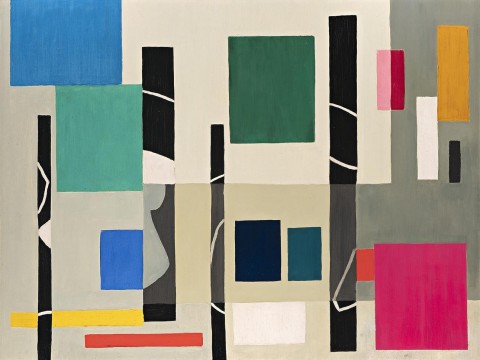CONSTRUCTIVE PAINTING, 1953
RALPH BALSON
oil on composition board
70.0 x 91.0 cm
signed verso: Balson
Estate of the artist, New South Wales
Thence by descent
Private collection, New South Wales
Ralph Balson, Second Memorial Exhibition, Gallery A, Sydney, 18 July 1968, cat. 23 (label attached verso)
Radical in his thoughts and remarkably well-read in international developments of the avant-garde, Ralph Balson is now regarded as the father of Australian abstract painting. Along with Grace Crowley, with whom he worked in close collaboration and mutual support, Balson ascribed to the Greenbergian modernist theory that art had its own teleology and was evolving towards an ideal form based on hard-edged geometry and harmonies of pure colour. Studying the work and theories of pioneering modernist artists in the United States, in particular, László Moholy-Nagy and Piet Mondrian, Balson created impersonal ‘objective’ geometric paintings with dynamic compositions that expressed his understanding of the universe. This idealism was a driving force in Balson’s career and encouraged the enterprising artist to constantly create and innovate his method of abstraction.
Constructive Painting, 1953, is a jaunty and playful composition of fractured rectangular planes. Although at first glance this painting appears to follow to the rectilinear grid-like composition characteristic of Balson’s Constructive paintings of the mid 1950s, movement is nevertheless introduced by an asymmetric and irregular distribution of forms. In destabilising the severity of the underlying grid with a placement of planes ever so slightly off-axis, each form outlined with irregular edges and visible brushstrokes, Balson expresses his own hand in the creation of this abstract painting.
Balson’s ‘Constructive’ abstractions were remarkably flat, emphasising the planar nature of the painted surface, the only element of depth remaining being a suggestion of superimposed layers , reminiscent of Moholy-Nagy’s paintings of the 1920s that Balson had certainly seen reproduced in publications.1 Through a manipulation of adjacent colour tones, Balson could transform a series of rectangles into a complex and dynamic composition of slipping and sliding planes. However, the interaction between Balson’s planes of opaque block colours is ambiguous, the succession of their layers is not uniform, some receding while their counterparts float to the foreground.
Echoing the Cubist practice of découpage, this illusion of transparency is a technique that Balson had translated into paint from the earliest phases of his preparatory process. Both Balson and Crowley created collages of semi-transparent coloured paper and string to map out their compositions.2 Constructive Painting, like other paintings of the time – Abstract Painting, 1947 by Grace Crowley and Balson’s own Constructive Painting, 1955 – retains a linear motif of a meandering ribbon, its startling graceful line unifying several shapes across the fractured picture plane. In contrast to his earlier Constructive Paintings, the brightly coloured forms of this work mostly exist alone, untethered to other planes and seeming to float above (or behind) their grey support. This fracturing and separation of form prefigures the total explosion of colour that would characterise Balson’s work from 1956 onwards, the ‘Non-Objective Paintings’.
Constructive Painting was created at a pivotal point in Balson’s career. While he remained for most of his life a quiet man removed from the social scene of the Sydney art world, it was in 1953 that Balson finally started to receive a solid critical reception. Not only did the Art Gallery of New South Wales acquire one of his Constructive Paintings for their permanent collection, but the Conference of Interstate Gallery Directors (a meeting of the directors of Australia’s major art museums) selected two of his paintings, both from the 1950s, to be included in a major diplomatic exhibition in London of the best contemporary Australian Art, Twelve Australian Artists, alongside established artists Russell Drysdale, Sidney Nolan and Arthur Boyd.3
1. Taylor, E., ‘Progression and Collaboration’, Grace Crowley Being Modern, exhibition catalogue, National Gallery of Australia, Canberra, 2006, p. 43
2. Evatt, M. A. ‘The Crowley–Fizelle Art School’, Quarterly, AGNSW Research Library and Archive, Sydney, October 1966, p. 315
3. Thomas, D., ‘Ralph Balson and Gallery A’, Gallery A Sydney 1964 – 1983, Campbelltown Arts Centre, New South Wales, 2009, p.106
LUCIE REEVES-SMITH
